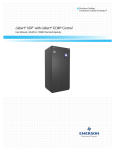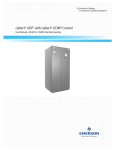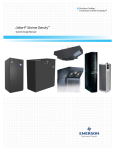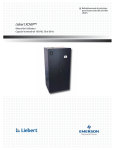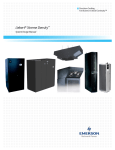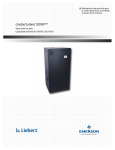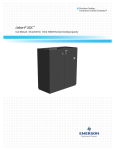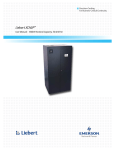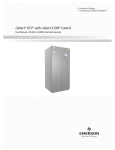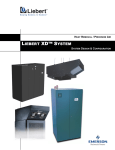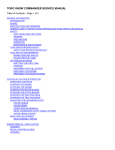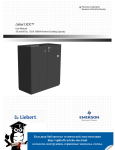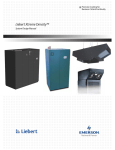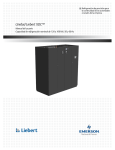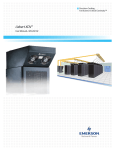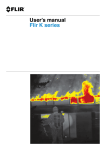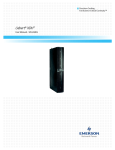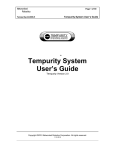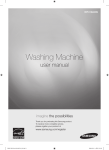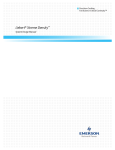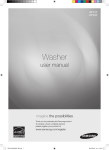Download Liebert® XDP™
Transcript
Precision Cooling For Business-Critical Continuity™ Liebert® XDP™ User Manual–50-60 Hz; 160kW Nominal Capacity GENERAL SAFETY GUIDELINES ! WARNING Risk of electric shock. Can cause injury or death. Disconnect local and remote power supplies before working within. Before proceeding with installation of the XDP, read all instructions, verify that all the parts are included and check the nameplate to be sure the XDP voltage matches the available utility power. Follow all applicable codes. ! WARNING Risk of unit falling over. Can cause death, injury or property damage. The XDP is top-heavy. Use extreme caution and care when moving and installing this unit. NOTE This document is intended to be be used together with site specific documentation and documentation for other parts of the system (heat rejection devices and cooling modules). NOTE Before any action that could cause a disturbance in the XD system’s cooling function is begun, the facility manager MUST be informed. In addition, after the action is taken and the work is finished, the facility manager MUST be informed. ! CAUTION Risk of piping and component rupture. May cause injury or equipment damage. Do not close service valves without following recommended procedures for repair, maintenance and replacement of components. Closing service valves may isolate liquid refrigerant, causing high pressure and rupture of piping. Install pressure relief valves in field piping that may become isolated by service valves. Figure i Model number nomenclature Example: XDP160A– –1 XD P 160 Pumping unit Liebert X-treme heat Density system R A Pump Redundancy 160kW nominal capacity – – Place holder A = 460V-3ph-60Hz (voltage-phase-frequency) C = 208V-3ph-60Hz M = 380/415-3ph-50Hz 1 Revision level Place holder Fluorinated Greenhouse Gas Requirements—European Union Stationary air conditioning, refrigeration, heat pump equipments and stationary fire protection systems in the European Community market and operating with fluorinated greenhouse gases (f-gas), such as R407C, R134a, R410A, must comply with the F-Gas Regulation: (EC) No. 842/2006 (F-gas). The regulation prohibits, among other actions, venting fluorinated greenhouse gases to the atmosphere. The F-Gas Regulation also requires operators to use use all measures that are technically feasible and do not entail disproportionate cost to prevent leakage of these gases, to test for leakage regularly and to recover f-gas during equipment service and maintenance and before disposing of equipment. Refer to the full regulation for additional details. TABLE OF CONTENTS GENERAL SAFETY GUIDELINES . . . . . . . . . . . . . . . . . . . . . . . . . . . . . . . . . . . INSIDE FRONT COVER 1.0 PRODUCT DESCRIPTION . . . . . . . . . . . . . . . . . . . . . . . . . . . . . . . . . . . . . . . . . . . . . . . . . . .1 1.1 General Product Information. . . . . . . . . . . . . . . . . . . . . . . . . . . . . . . . . . . . . . . . . . . . . . . . . . . 1 1.1.1 Product/System Description. . . . . . . . . . . . . . . . . . . . . . . . . . . . . . . . . . . . . . . . . . . . . . . . . . . . . 1 1.2 Equipment Inspection . . . . . . . . . . . . . . . . . . . . . . . . . . . . . . . . . . . . . . . . . . . . . . . . . . . . . . . . 1 1.3 Equipment Handling . . . . . . . . . . . . . . . . . . . . . . . . . . . . . . . . . . . . . . . . . . . . . . . . . . . . . . . . . 2 1.3.1 1.3.2 1.3.3 1.4 Handling With Skid . . . . . . . . . . . . . . . . . . . . . . . . . . . . . . . . . . . . . . . . . . . . . . . . . . . . . . . . . . . 2 Removal from Skid . . . . . . . . . . . . . . . . . . . . . . . . . . . . . . . . . . . . . . . . . . . . . . . . . . . . . . . . . . . . 2 Removing Piano Jacks . . . . . . . . . . . . . . . . . . . . . . . . . . . . . . . . . . . . . . . . . . . . . . . . . . . . . . . . . 4 Mechanical Considerations . . . . . . . . . . . . . . . . . . . . . . . . . . . . . . . . . . . . . . . . . . . . . . . . . . . . 5 1.4.1 Positioning the Liebert XDP . . . . . . . . . . . . . . . . . . . . . . . . . . . . . . . . . . . . . . . . . . . . . . . . . . . . 5 1.5 Electrical Information . . . . . . . . . . . . . . . . . . . . . . . . . . . . . . . . . . . . . . . . . . . . . . . . . . . . . . . . 7 1.6 High Voltage Connections . . . . . . . . . . . . . . . . . . . . . . . . . . . . . . . . . . . . . . . . . . . . . . . . . . . . . 7 1.6.1 Connecting High-Voltage Cables . . . . . . . . . . . . . . . . . . . . . . . . . . . . . . . . . . . . . . . . . . . . . . . . . 7 1.7 Extra Low Voltage (ELV) Connections . . . . . . . . . . . . . . . . . . . . . . . . . . . . . . . . . . . . . . . . . . . 9 2.0 PIPING . . . . . . . . . . . . . . . . . . . . . . . . . . . . . . . . . . . . . . . . . . . . . . . . . . . . . . . . . . . . . . . 11 2.1 European Union Fluorinated Greenhouse Gas Requirements . . . . . . . . . . . . . . . . . . . . . . . 11 2.2 Connection Sizes. . . . . . . . . . . . . . . . . . . . . . . . . . . . . . . . . . . . . . . . . . . . . . . . . . . . . . . . . . . . 11 2.2.1 Recommended Pipe Size. . . . . . . . . . . . . . . . . . . . . . . . . . . . . . . . . . . . . . . . . . . . . . . . . . . . . . . 11 2.3 Liebert XDP Interconnection with Liebert XD Cooling Modules . . . . . . . . . . . . . . . . . . . . . 12 2.4 Piping Installation Method . . . . . . . . . . . . . . . . . . . . . . . . . . . . . . . . . . . . . . . . . . . . . . . . . . . 12 2.4.1 2.5 Bypass Flow Controller . . . . . . . . . . . . . . . . . . . . . . . . . . . . . . . . . . . . . . . . . . . . . . . . . . . . . . . 12 Piping Details—Shut-Off/Isolation Valves . . . . . . . . . . . . . . . . . . . . . . . . . . . . . . . . . . . . . . . 15 2.5.1 2.5.2 2.5.3 Piping Installation Method . . . . . . . . . . . . . . . . . . . . . . . . . . . . . . . . . . . . . . . . . . . . . . . . . . . . 15 Piping Mains . . . . . . . . . . . . . . . . . . . . . . . . . . . . . . . . . . . . . . . . . . . . . . . . . . . . . . . . . . . . . . . . 15 Evacuation and Leak Check . . . . . . . . . . . . . . . . . . . . . . . . . . . . . . . . . . . . . . . . . . . . . . . . . . . 15 2.6 Checklist for Proper Installation . . . . . . . . . . . . . . . . . . . . . . . . . . . . . . . . . . . . . . . . . . . . . . . 16 3.0 CHECKLIST FOR LIEBERT XDP STARTUP . . . . . . . . . . . . . . . . . . . . . . . . . . . . . . . . . . . . . 17 3.1 Filling the Pumped Circuit—R-134a. . . . . . . . . . . . . . . . . . . . . . . . . . . . . . . . . . . . . . . . . . . . 18 3.1.1 Calculating Refrigerant Charge—Example . . . . . . . . . . . . . . . . . . . . . . . . . . . . . . . . . . . . . . . 20 4.0 MICROPROCESSOR CONTROL . . . . . . . . . . . . . . . . . . . . . . . . . . . . . . . . . . . . . . . . . . . . . . 21 4.1 Feature Overview . . . . . . . . . . . . . . . . . . . . . . . . . . . . . . . . . . . . . . . . . . . . . . . . . . . . . . . . . . . 21 4.1.1 4.2 Display . . . . . . . . . . . . . . . . . . . . . . . . . . . . . . . . . . . . . . . . . . . . . . . . . . . . . . . . . . . . . . . . . . . . 21 Controls . . . . . . . . . . . . . . . . . . . . . . . . . . . . . . . . . . . . . . . . . . . . . . . . . . . . . . . . . . . . . . . . . . . 22 4.2.1 Feature Overview . . . . . . . . . . . . . . . . . . . . . . . . . . . . . . . . . . . . . . . . . . . . . . . . . . . . . . . . . . . . 22 i 4.3 Main Menu . . . . . . . . . . . . . . . . . . . . . . . . . . . . . . . . . . . . . . . . . . . . . . . . . . . . . . . . . . . . . . . . 22 4.3.1 4.3.2 4.3.3 4.3.4 4.3.5 4.3.6 4.3.7 4.3.8 4.3.9 4.3.10 4.3.11 4.3.12 4.3.13 4.3.14 4.3.15 4.3.16 Viewing or Changing Settings . . . . . . . . . . . . . . . . . . . . . . . . . . . . . . . . . . . . . . . . . . . . . . . . . . SETPOINTS . . . . . . . . . . . . . . . . . . . . . . . . . . . . . . . . . . . . . . . . . . . . . . . . . . . . . . . . . . . . . . . . STATUS . . . . . . . . . . . . . . . . . . . . . . . . . . . . . . . . . . . . . . . . . . . . . . . . . . . . . . . . . . . . . . . . . . . ACTIVE ALARMS . . . . . . . . . . . . . . . . . . . . . . . . . . . . . . . . . . . . . . . . . . . . . . . . . . . . . . . . . . . ALARM HISTORY . . . . . . . . . . . . . . . . . . . . . . . . . . . . . . . . . . . . . . . . . . . . . . . . . . . . . . . . . . . TIME . . . . . . . . . . . . . . . . . . . . . . . . . . . . . . . . . . . . . . . . . . . . . . . . . . . . . . . . . . . . . . . . . . . . . . DATE. . . . . . . . . . . . . . . . . . . . . . . . . . . . . . . . . . . . . . . . . . . . . . . . . . . . . . . . . . . . . . . . . . . . . . SETUP OPERATION . . . . . . . . . . . . . . . . . . . . . . . . . . . . . . . . . . . . . . . . . . . . . . . . . . . . . . . . . Password Security—SETPT PASSWORD and SERVICE PASSWORD . . . . . . . . . . . . . . . . . CALIBRATE SENSOR . . . . . . . . . . . . . . . . . . . . . . . . . . . . . . . . . . . . . . . . . . . . . . . . . . . . . . . . ALARM ENABLE. . . . . . . . . . . . . . . . . . . . . . . . . . . . . . . . . . . . . . . . . . . . . . . . . . . . . . . . . . . . ALARM TIME DELAY. . . . . . . . . . . . . . . . . . . . . . . . . . . . . . . . . . . . . . . . . . . . . . . . . . . . . . . . COM ALARM ENABLE . . . . . . . . . . . . . . . . . . . . . . . . . . . . . . . . . . . . . . . . . . . . . . . . . . . . . . . CUSTOM ALARMS . . . . . . . . . . . . . . . . . . . . . . . . . . . . . . . . . . . . . . . . . . . . . . . . . . . . . . . . . . CUSTOM TEXT . . . . . . . . . . . . . . . . . . . . . . . . . . . . . . . . . . . . . . . . . . . . . . . . . . . . . . . . . . . . . DIAGNOSTICS. . . . . . . . . . . . . . . . . . . . . . . . . . . . . . . . . . . . . . . . . . . . . . . . . . . . . . . . . . . . . . 22 23 23 23 23 24 24 24 26 27 27 27 27 28 28 28 5.0 ALARM DESCRIPTIONS AND SOLUTIONS . . . . . . . . . . . . . . . . . . . . . . . . . . . . . . . . . . . . . .29 5.1 Alarm Descriptions. . . . . . . . . . . . . . . . . . . . . . . . . . . . . . . . . . . . . . . . . . . . . . . . . . . . . . . . . . 29 5.2 Red and Green Lamp Indicators . . . . . . . . . . . . . . . . . . . . . . . . . . . . . . . . . . . . . . . . . . . . . . . 30 5.3 Alter Alarm Settings . . . . . . . . . . . . . . . . . . . . . . . . . . . . . . . . . . . . . . . . . . . . . . . . . . . . . . . . 30 5.3.1 5.3.2 Enable or Disable Alarms . . . . . . . . . . . . . . . . . . . . . . . . . . . . . . . . . . . . . . . . . . . . . . . . . . . . . 30 Increase or Decrease Alarm Time Delays . . . . . . . . . . . . . . . . . . . . . . . . . . . . . . . . . . . . . . . . . 31 5.4 System Shutdown Causes . . . . . . . . . . . . . . . . . . . . . . . . . . . . . . . . . . . . . . . . . . . . . . . . . . . . 31 6.0 TROUBLESHOOTING . . . . . . . . . . . . . . . . . . . . . . . . . . . . . . . . . . . . . . . . . . . . . . . . . . . . . 32 7.0 MAINTENANCE . . . . . . . . . . . . . . . . . . . . . . . . . . . . . . . . . . . . . . . . . . . . . . . . . . . . . . . . . 33 7.1 Fluorinated Greenhouse Gas Requirements. . . . . . . . . . . . . . . . . . . . . . . . . . . . . . . . . . . . . . 33 8.0 SPECIFICATIONS . . . . . . . . . . . . . . . . . . . . . . . . . . . . . . . . . . . . . . . . . . . . . . . . . . . . . . . .34 ii FIGURES Figure i Figure 1 Figure 2 Figure 3 Figure 4 Figure 5 Figure 6 Figure 7 Figure 8 Figure 9 Figure 10 Figure 11 Figure 12 Figure 13 Figure 14 Figure 15 Figure 16 Figure 17 Figure 18 Figure 19 Figure 20 Figure 21 Figure 22 Model number nomenclature . . . . . . . . . . . . . . . . . . . . . . . . . . . . . . . . . . . . . . . . . Inside Front Cover Liebert XDP components . . . . . . . . . . . . . . . . . . . . . . . . . . . . . . . . . . . . . . . . . . . . . . . . . . . . . . . . . . 1 Tie-down brackets and lag bolts to be removed. . . . . . . . . . . . . . . . . . . . . . . . . . . . . . . . . . . . . . . . . 2 Removing pallet boards for piano jack insertion . . . . . . . . . . . . . . . . . . . . . . . . . . . . . . . . . . . . . . . . 3 Liebert XDP strapped to piano jack . . . . . . . . . . . . . . . . . . . . . . . . . . . . . . . . . . . . . . . . . . . . . . . . . . 3 Remove remaining lag bolts from one runner . . . . . . . . . . . . . . . . . . . . . . . . . . . . . . . . . . . . . . . . . . 3 Remove runner from pallet. . . . . . . . . . . . . . . . . . . . . . . . . . . . . . . . . . . . . . . . . . . . . . . . . . . . . . . . . 4 Sliding pallet from under Liebert XDP . . . . . . . . . . . . . . . . . . . . . . . . . . . . . . . . . . . . . . . . . . . . . . . 4 Dimensions . . . . . . . . . . . . . . . . . . . . . . . . . . . . . . . . . . . . . . . . . . . . . . . . . . . . . . . . . . . . . . . . . . . . . 5 Piping access points . . . . . . . . . . . . . . . . . . . . . . . . . . . . . . . . . . . . . . . . . . . . . . . . . . . . . . . . . . . . . . 6 Front view of Liebert XDP and electrical enclosure . . . . . . . . . . . . . . . . . . . . . . . . . . . . . . . . . . . . . 7 Electrical enclosure knockout locations for field wiring . . . . . . . . . . . . . . . . . . . . . . . . . . . . . . . . . . 8 High voltage connections—60Hz . . . . . . . . . . . . . . . . . . . . . . . . . . . . . . . . . . . . . . . . . . . . . . . . . . . . 8 High voltage connections—50Hz . . . . . . . . . . . . . . . . . . . . . . . . . . . . . . . . . . . . . . . . . . . . . . . . . . . . 9 Electrical enclosure knockout locations for Extra Low Voltage . . . . . . . . . . . . . . . . . . . . . . . . . . . . 9 Liebert XDP extra low voltage field connections points . . . . . . . . . . . . . . . . . . . . . . . . . . . . . . . . . 10 Piping arrangement for Liebert XDP/Liebert XDC used with Liebert XD cooling modules . . . . 12 Bypass flow controller details, dimensions . . . . . . . . . . . . . . . . . . . . . . . . . . . . . . . . . . . . . . . . . . . 13 Bypass flow controller arrangement . . . . . . . . . . . . . . . . . . . . . . . . . . . . . . . . . . . . . . . . . . . . . . . . 13 Bypass flow controller piping . . . . . . . . . . . . . . . . . . . . . . . . . . . . . . . . . . . . . . . . . . . . . . . . . . . . . . 14 General piping details . . . . . . . . . . . . . . . . . . . . . . . . . . . . . . . . . . . . . . . . . . . . . . . . . . . . . . . . . . . 15 System R-134a liquid level . . . . . . . . . . . . . . . . . . . . . . . . . . . . . . . . . . . . . . . . . . . . . . . . . . . . . . . . 18 User interface . . . . . . . . . . . . . . . . . . . . . . . . . . . . . . . . . . . . . . . . . . . . . . . . . . . . . . . . . . . . . . . . . . 21 TABLES Table 1 Table 2 Table 3 Table 4 Table 5 Table 6 Table 7 Table 8 Table 9 Table 10 Table 11 Table 12 Table 13 Table 14 Table 15 Table 16 Table 17 Liebert XDP dimensions . . . . . . . . . . . . . . . . . . . . . . . . . . . . . . . . . . . . . . . . . . . . . . . . . . . . . . . . . . . 5 Unit piping outlet connection sizes, inches, OD Cu . . . . . . . . . . . . . . . . . . . . . . . . . . . . . . . . . . . . . 6 Supply, return pipe sizes for refrigerant loop . . . . . . . . . . . . . . . . . . . . . . . . . . . . . . . . . . . . . . . . . 11 Bypass flow controllers for a Liebert XDP-based system . . . . . . . . . . . . . . . . . . . . . . . . . . . . . . . . 13 Liebert XDP pump light indicator—208V and 400V units . . . . . . . . . . . . . . . . . . . . . . . . . . . . . . . 17 System refrigerant charge for the supply and return mains . . . . . . . . . . . . . . . . . . . . . . . . . . . . . 19 R-134a refrigerant charge for hard-piped connector lines to and from any model Liebert XDH/Liebert XDO/Liebert XDV/Liebert XDCF . . . . . . . . . . . . . . . . . . . . . . . . . . . . . . . . . 19 R-134a refrigerant charge for Flex Pipe connector lines to and from any model Liebert XDO/Liebert XDH/Liebert XDV/Liebert XDCF . . . . . . . . . . . . . . . . . . . . . . . . . . . . . . . . . 19 System R-134a charge for a Liebert XDP with any model Liebert XDH/Liebert XDO/Liebert XDV/Liebert XDCF . . . . . . . . . . . . . . . . . . . . . . . . . . . . . . . . . . . . . . . . . . . . . . . . . . . 19 Calculating refrigerant charge—example . . . . . . . . . . . . . . . . . . . . . . . . . . . . . . . . . . . . . . . . . . . . 20 Worksheet to calculate refrigerant charge . . . . . . . . . . . . . . . . . . . . . . . . . . . . . . . . . . . . . . . . . . . 20 User interface keypad functions. . . . . . . . . . . . . . . . . . . . . . . . . . . . . . . . . . . . . . . . . . . . . . . . . . . . 21 Setpoint functions, default values and allowable ranges . . . . . . . . . . . . . . . . . . . . . . . . . . . . . . . . 23 Setup operation functions default values and allowable ranges. . . . . . . . . . . . . . . . . . . . . . . . . . . 24 Liebert XDP DIP switches and factory settings . . . . . . . . . . . . . . . . . . . . . . . . . . . . . . . . . . . . . . . 25 Troubleshooting the XDP . . . . . . . . . . . . . . . . . . . . . . . . . . . . . . . . . . . . . . . . . . . . . . . . . . . . . . . . . 32 Liebert XDP160 specifications . . . . . . . . . . . . . . . . . . . . . . . . . . . . . . . . . . . . . . . . . . . . . . . . . . . . . 34 iii iv Product Description 1.0 PRODUCT DESCRIPTION 1.1 General Product Information 1.1.1 Product/System Description Liebert’s XDP refrigerant distribution unit is an interface between the building chilled water system and the cooling modules in the Liebert XD system. It is designed to circulate and control refrigerant to the cooling modules that are in the room with heat-producing equipment. The Liebert XDP consists of a cabinet that includes a heat exchanger, circulating pump(s), control valve, receiver, controls, valves and piping. The Liebert XDP monitors room conditions and prevents coil condensation by maintaining the refrigerant being pumped to the cooling modules at a temperature above the room’s dew point. All functions, such as switching pumps (if applicable), controlling refrigerant temperature, etc., are automatic. The Liebert XDP’s minimum recommended operating load is 20% of system nominal capacity. For example, a Liebert XDP160 60Hz system’s minimum load would be 32 kW. Loading below this value can unfavorably affect system operation. Consult factory for any loading below this recommendation. The Liebert XDP is rated for 160kW (546,000 BTU/H) of cooling. Figure 1 Liebert XDP components Liebert XDP Unit Liebert XD Cooling Modules Control Valve Chilled Water Heat Exchanger 1.2 Receiver Pumps Equipment Inspection When the unit is delivered, inspect all items for visible and concealed damage. Damage should be immediately reported to the carrier and a damage claim filed with a copy sent to Liebert or to your sales representative. 1 Product Description 1.3 Equipment Handling ! WARNING Risk of unit falling over. Can cause injury or death. The Liebert XDP is top-heavy. Use extreme caution and care when moving and installing this unit. NOTE Personnel should be properly trained and certified to move and rig equipment. 1.3.1 Handling With Skid • Always keep the unit upright, indoors and protected from damage. • If possible, transport the unit using a forklift truck. Otherwise use a crane with belts or cables. In either case, do NOT press on the top edges of the packaging. • If using a forklift, make sure the forks (if adjustable) are spread to the widest allowable distance to still fit under the skid. • When moving the skidded unit with a forklift truck, do not lift the unit any higher than 6" (152mm) off the ground. If circumstances require the unit to be lifted higher than 6" (152mm), great care must be exercised and all by-standing personnel are to be no closer than 20 feet (6m) from the lift point of the unit. ! CAUTION Risk of structural interference. Can cause equipment or building damage. While on the skid, the unit is too tall (83" [2108mm] overall height) to fit through a standard doorway. Any attempt to move the unit, while skidded, through a standard doorway will cause damage to the unit and to the building. 1.3.2 Removal from Skid Liebert recommends using dual hand trucks or a similar method to remove the Liebert XDP from the skid. This is to ensure that both ends of the unit are firmly secure and to provide a good means of unit mobility. 1. Always keep the unit upright, indoors and protected from possible damage. 2. Remove the exterior packaging. Leave the plastic bag over the Liebert XDP until the unit has been moved to its final location. The bag will protect the painted panels against scuffing. 3. Remove two (2) corner tie-down brackets from one side of the unit, on a non-runner notch side of the pallet. Remove eight (8) lag bolts from two (2) end deck boards on the same end where the tie-down brackets were removed (refer to Figure 2). Figure 2 Tie-down brackets and lag bolts to be removed Remove these 4 lag bolts to free deck boards Remove these 2 tie-down brackets Remove these 4 lag bolts to free deck boards 2 Product Description 4. Remove the two (2) end deck boards from one end of the pallet and the attached, notched section of the center runners (refer to Figure 3). Figure 3 Removing pallet boards for piano jack insertion Remove two deck boards ... ... and center runner sections from one end of pallet. 5. Place a piano jack with its forks snugly against the bottom of the unit and strap the Liebert XDP securely to the jack (refer to Figure 4). NOTE Place a mover’s blanket or other cushioning material between the piano jack and the unit’s side panels. Figure 4 Liebert XDP strapped to piano jack Piano jack Strap secures the Liebert XDP to the jack Place cushioning material between the forks and the Liebert XDP to protect unit’s finish (cushion not shown for clarity) Piano jack’s forks should be snug against the Liebert XDP 6. Repeat Steps 2, 4 and 5 for the opposite side of the unit. When these steps have been completed, the Liebert XDP will be supported by two piano jacks, one on either side. 7. Remove all of the remaining lag bolts from one (1) of the pallet’s outside runners (see Figure 5). Figure 5 Remove remaining lag bolts from one runner Remaining 6 lag bolts to remove 3 Product Description 8. Remove the runner from which all lag bolts have been removed (refer to Figure 6). Figure 6 Remove runner from pallet Slide this runner away from the Liebert XDP 9. Using the pallet jacks, raise the secured unit to the highest point that the piano jacks will allow. Once the unit has been raised, slide the remainder of the pallet from under the Liebert XDP (see Figure 7). Lower the Liebert XDP so that its base is approximately 1" (25.4mm) off the ground. Figure 7 Sliding pallet from under Liebert XDP Slide the remaining part of the pallet from under the Liebert XDP so the unit may be moved on the piano jacks. 1.3.3 Removing Piano Jacks Once the unit has been moved to the installation location, Emerson Network Power recommends the following method to remove the piano jacks: 1. 2. 3. 4. Lower the unit as far as the piano jacks will allow. Undo all strapping holding the piano jacks to the unit. Remove all cushioning material used to protect the unit from the straps and the piano jacks. Use a pry bar or other lever to lift one side of the Liebert XDP enough to allow removal of the piano jack. 5. Repeat Step 4 to remove the piano jack on the opposite side. 6. Remove the plastic bag. 4 Product Description 1.4 Mechanical Considerations 1.4.1 Positioning the Liebert XDP Install the Liebert XDP according to the site specific documentation and secure the unit to the floor. The Liebert XDP can be installed near a wall or another Liebert XDP. However, there must be at least 3 feet (92cm) clearance in front of the Liebert XDP as service access for components in the unit. For additional technical information, refer to the System Design and Configuration Document for the Liebert XD™ System, SL-16655. The document is available in electronic format at Liebert’s Web site, www.liebert.com, as well as from your local Emerson Network Power representative. Figure 8 Dimensions A Overall B Overall C Side Panel E m) 7m 2 1 5" ( D 78" (1981mm) 1" (25mm) 5-1/2" (140mm) 11" (279mm) Floor Cutout Dimensions D Unit Base The shaded area indicates a recommended clearance of 36" (914mm) for component access. E Unit Base Unit Dimensional Data Table 1 DPN000767 Pg. 2, Rev. 6 Liebert XDP dimensions Dimensional Data inches (mm) Shipping Weight, lb (kg) Model 50/60Hz A B* C D E Domestic Export XDP160 38 (965) 34 (864) 33-1/8 (841) 33 (838) 36 (914) 990 (449) 1067 (484) * The dimension does not include the bezel of the disconnect switch. 5 Product Description Figure 9 Piping access points To first cooling module or bypass flow controller ** Install replaceable filter dryer assembly in liquid supply line B. * Orientation determined by installer. A - Return From Cooling Modules B - Supply to Cooling Modules 17-1/4" (438mm) 16-1/8" (410mm) 10" (254mm) 19" (483mm) Dimensions are approximate and subject to change without notice. C - Chilled Water Supply From Chilled Water Source D - Chilled Water Return To Chilled Water Source * Allow 8" (204mm) clearance for filter replacement. ** To ensure ensure all refrigerant flow is filtered, install the filter dryer assembly between the discharge line of the Liebert XDP and the first bypass flow controller or the first cooling module. Table 2 Unit piping outlet connection sizes, inches, OD Cu Model Pipe Connection Point 50/60 Hz A B C D XDP160 2-1/8 1-1/8 2-5/8 2-5/8 6 DPN000767 Pg. 3, Rev. 6 Product Description 1.5 Electrical Information 1.6 High Voltage Connections Make sure the actual supply voltage and frequency correspond to the voltage and frequency indicated on the Liebert XDP’s rating plate. The unit must be installed in accordance with national wiring regulations. Connect cables for high voltage supply to the electrical box in the Liebert XDP according to Figure 12 and make sure that the phases are correctly connected. ! WARNING Risk of electric shock. Can cause injury or death. Disconnect all local and remote electric power before working within the unit. ! CAUTION Risk of sharp edges and heavy parts. Can cause injury or equipment damage. Wear gloves to prevent injury to hands. Damage to wiring or components may make unit unsafe to operate. Use caution when installing wiring to prevent damage to factory wiring. Install protective bushings in wiring knockouts as required. Do not disturb factory wiring or route field-installed wiring over electrical terminals. Use NEC Class 1 wiring for all hazardous voltage electrical power supplies. Check and retighten all wiring connections before starting. 1.6.1 Connecting High-Voltage Cables 1. Turn the Liebert XDP’s disconnect switch to the Off position (see Figure 10). Open the front doors and push down on the enclosure cover latch to open the hazardous voltage enclosure cover. Figure 10 Front view of Liebert XDP and electrical enclosure Status Lamps Disconnect Switch User Interface Enclosure Cover Latch Hazardous Voltage Enclosure Cover Front of Liebert XDP 7 Product Description 2. Determine which knockouts in the electrical enclosure will be used and remove them (see Figure 11). Figure 11 Electrical enclosure knockout locations for field wiring User Interface (Wall Box) Wiring Liebert XD Module Condensate Connections (optional; depends on features supplied with Liebert XD Module) Temperature/Humidity Sensor Wiring Alternate Knockout for Temperature/Humidity Sensor Wiring Enclosure Cover Not Shown for Clarity 3. Route the input hazardous voltage electrical power wiring through the top left knockout (see Figure 11) to the disconnect switch L1, L2 and L3 (see Figures 12 and 13). Observe proper phasing. 4. Connect the ground wire to the ground lug (see Figures 12 and 13), which is in the middle left of the enclosure. Figure 12 High voltage connections—60Hz Customer Power Connection Ground Lug Disconnect Switch Transformer 2 Pump Fuse Blocks Power Block Control Fuse Blocks Transformer 1 Pump Contactors 8 Product Description Figure 13 High voltage connections—50Hz Customer Power Connection Ground Lug Disconnect Switch Transformer 2 Pump Circuit Breakers Busbar Power Block Fuse Blocks Transformer 1 Pump Contactors 1.7 Extra Low Voltage (ELV) Connections Extra Low Voltage power output is 30V and 100VA or less. 1. Turn off all unit power before connecting cables or wires. Failure to do so may damage this equipment (refer to Figure 14). 2. Route low voltage electrical connections through the appropriate knockouts as indicated below. 3. User interface requires four thermostat-type wires (jacketed) connected to the control board (see Figure 15). Figure 14 Electrical enclosure knockout locations for Extra Low Voltage User Interface (Wall Box) Wiring Liebert XD Module Condensate Connections (optional; depends on features supplied with Liebert XD Module) Temperature/Humidity Sensor Wiring Alternate Knockout for Temperature/Humidity Sensor Wiring Enclosure Cover Not Shown for Clarity 9 Product Description Field Connections—All Units • Connect the control display panel cable to terminal block TB3 terminals 1 through 4 on the Liebert XDP control board as shown (refer to Figure 15). The display panel may be mounted on the Liebert XDP’s front right door if the Liebert XDP is located in the area that it conditions. The display panel must always be installed in the conditioned space. • Connect the provided remote temperature / humidity sensor extension cable to the factory-installed cable connected to P16 on the control board. Install the sensor in the highertemperature portion of the cold aisle where the XD modules are located. Alternatively, it can be placed on the return air side of the primary air mover (e.g., Liebert Deluxe System/3™) in the room if it represents the conditions where all the XD cooling modules are located. Do not install the sensor where ambient air may cause false readings, for example, near unsealed doors, windows and similar areas. Field Connections—Optional for All Units • Connect field wiring from the optional Liebert XD cooling module condensation detection circuit to terminal strip locations H2O (24) and XDOC (51). • Connect optional field wiring from remote devices to remote alarm device, common alarm output, site monitor and remote shutdown, if applicable. See terminal strip descriptions in Figure 15. Figure 15 Liebert XDP extra low voltage field connections points Control Display Panel Four thermostatic wires to be connected toTB3 Temperature/Humidity Sensor Cable Provided with Temperature/Humidity Sensor Board TS-3 TS-4 TS-5 TS-6 Factory-Wired Temperature Sensor(s) H2O (24) RAD1 (50) XDOC (51) K3COM K3NO K3NCL 37 38 77 78 Control wiring must be Class 2 and installed in accordance with the National Electrical Code (NEC) Requires shielded cable 10 Piping 2.0 PIPING 2.1 European Union Fluorinated Greenhouse Gas Requirements Stationary air conditioning, refrigeration, heat pump equipments and stationary fire protection systems in the European Community market and operating with fluorinated greenhouse gases (f-gas), such as R407C, R134a, R410A, must comply with the F-Gas Regulation: (EC) No. 842/2006 (F-gas). The regulation prohibits, among other actions, venting fluorinated greenhouse gases to the atmosphere. The F-Gas Regulation requires operators to use use all measures that are technically feasible and do not entail disproportionate cost to prevent leakage of these gases, to test for leakage regularly and to recover f-gas before disposing of equipment, as well as during service and maintenance. Refer to the full regulation for additional details. 2.2 Connection Sizes The copper pipe connections on the Liebert XDP are: 2.2.1 Building Chilled Water Supply 2-5/8" OD Building Chilled Water Return 2-5/8" OD Refrigerant Supply 1-1/8" OD Refrigerant Return 2-1/8" OD Recommended Pipe Size Connect the main pipes between the Liebert XDP and the Liebert XD cooling modules according to site specific documentation and the configuration guide for the Liebert XD system. Elbows and restrictions must be minimized to get good fluid flow. Table 3 Supply, return pipe sizes for refrigerant loop Pipe Function Size / Equivalent Pipe Length Liebert XDP supply line, from Liebert XDP supply to farthest Liebert XD cooling module 1-1/8" OD for lengths up to 60 feet 1-3/8" OD for lengths over 60 but less than 175 feet Liebert XDP return line, from farthest Liebert XD cooling 2-1/8" OD for lengths up to 60 feet module to Liebert XDP return 2-5/8" OD for lengths over 60 but less than 175 feet From any model Liebert XDO/Liebert XDH supply to supply line of Liebert XDP 1/2" OD for lengths up to 10 feet From any model Liebert XDO/Liebert XDH return to return line of Liebert XDP 7/8" OD for lengths up to 10 feet From any model Liebert XDV/Liebert XDCF supply to supply line of Liebert XDP 1/2" OD for lengths up to 10 feet From any model Liebert XDV/Liebert XDCF return to return line of Liebert XDP 5/8" OD for lengths up to 10 feet 11 7/8" OD for lengths over 10 but less than 25 feet 1-1/8" OD for lengths over 10 but less than 25 feet 5/8" OD for lengths over 10 but less than 35 feet 7/8" OD for lengths over 10 but less than 35 feet Piping 2.3 Liebert XDP Interconnection with Liebert XD Cooling Modules All piping must be ASTM (American Society for Testing and Materials) Type L copper pipe. The Liebert XDP may be connected to Liebert XD cooling modules with either Liebert’s XD prefabricated piping assembly or with rigid, off-the-shelf piping. In either setup, piping for the Liebert XD system is arranged in a manner similar to piping for a chilled water system. Liebert XD cooling modules are connected in parallel between main return and supply pipes going to and from the Liebert XDP/Liebert XDC. For piping details, refer to Liebert’s XD System Design Manual, SL-16655. The guidelines provided for pipe size must be strictly followed. Failure to size the main lines and connection lines adequately may result in reduced cooling capacity. The critical aspects of pipe sizing are related to refrigerant volume and pressure drop. Both must be minimized. Figure 16 Piping arrangement for Liebert XDP/Liebert XDC used with Liebert XD cooling modules Liebert XD Cooling Modules Liebert XD Cooling Modules Liebert XD Cooling Modules Liebert XD Cooling Modules Liebert XD Cooling Modules All supply and return mains must be level with or above the top of all Liebert XD modules SLOPE—The main supply and return lines to and from the Liebert XDP/Liebert XDC Liebert XDP/ must be sloped downward toward the Liebert XDP/Liebert XDC at a rate of 1-2" per Liebert XDC 20 feet (25.4-51mm per 6m) of pipe run. Horizontal connector lines should also be sloped downward from the cooling modules toward the main supply and return lines. 2.4 Piping Installation Method The assembly and connection means used for piping in the Liebert XD system are similar to that of conventional refrigeration systems. All piping should be installed with high-temperature brazed joints. Brazing material may be used, but soft soldering is not recommended. If brazing material is used, the lines being brazed MUST be filled with flowing dry nitrogen during brazing to prevent excessive oxidation and scale formation inside the piping. Prevailing good refrigeration practices should be employed for piping supports, leak testing, dehydration and charging. Insulate all piping lines to prevent condensation in applications where the dew point approaches the R-134a refrigerant temperature. 2.4.1 Bypass Flow Controller Some installations require one or more bypass flow controller(s) to ensure that the Liebert XDP’s pumps operate within the optimum range. These devices are added to the field piping and simulate the flow of additional cooling modules. Each bypass flow controller should be installed with one shutoff valve to allow the controller to be disabled when cooling modules are added to a Liebert XD system. If bypass flow controllers are required, they should be connected between the main supply and the main return lines of the field piping. The connection points to the main supply and return lines should be in a convenient and accessible location between the Liebert XDP and the first Liebert XD module in the circuit. See Figures 17 and 18 for piping details of the bypass flow controller. Refer to Table 4 to determine the number of bypass flow controllers needed, based on the total nominal cooling capacity of the cooling modules in each Liebert XD system. 12 Piping Table 4 Bypass flow controllers for a Liebert XDP-based system Cooling Modules Cumulative Model Size Required Number of Bypass Flow Controllers Liebert XDP 32 to 63 3 64 to 95 2 96 to 127 1 128 to 160 0 Figure 17 Bypass flow controller details, dimensions 4” (102mm) 7/8” (22mm) ID Figure 18 Bypass flow controller arrangement 7/8" Refrigerant Grade Full Port Ball Valve Field-Supplied and Field-Installed Flow Direction Bypass Flow Controller (Field-Installed) Supply Main 13 Return Main Piping Figure 19 Bypass flow controller piping Liebert XD Cooling Module #1 Bypass Flow Controllers Coolant Supply Coolant Return Filter Dryer Assembly Liebert XDP or Liebert XDC 14 Liebert XD Cooling Module #2 Piping 2.5 Piping Details—Shut-Off/Isolation Valves To allow for maintenance of the Liebert XDP, isolation valves must be installed on the chilled water circuit (see Figure 20). Figure 20 General piping details Return Supply Return Supply Liebert XDP A Liebert XDP B Floor Isolation valves Isolation valves Building Chilled Water Supply Building Chilled Water Return 2.5.1 Piping Installation Method All piping should be installed with high temperature brazed joints. Prevailing good refrigeration practices should be employed for piping supports, leak testing, dehydration and charging. Emerson Network Power highly recommends venting the pressure relief of the Liebert XDP (located at the top of the receiver) outside of the conditioned space where it is open to the atmosphere. 2.5.2 Piping Mains All refrigeration piping mains, both supply and return, should be installed with a downward pitch toward the Liebert XDP of 1-2" for every 20 feet (25.4-51mm per 6m) of pipe run. Install a 20-40 mesh strainer on the chilled water supply to the Liebert XDP. The strainer is needed to prevent particles in the chilled water from entering the heat exchanger of the Liebert XDP. 2.5.3 Evacuation and Leak Check 1. Open all service valves, including those located outside of the Liebert XDP. 2. Place 150 psig (1034kPa; 10.34 bars) of dry nitrogen with a tracer of R-134a in the system. ! CAUTION Risk of overpressurization. Can cause equipment damage. Do not exceed 150 psig (1034 kPa; 10.34 bars) in the R-134a circuit. 3. Check the system for leaks with a suitable leak finder 4. After completion of the leak testing, release the test pressure (per local code) and connect to vacuum pump(s) at the Schrader valves. 5. After four hours of pulling a deep vacuum, check the vacuum level and if it has not changed, break the vacuum with dry nitrogen. 6. Pull a second vacuum to 250 microns or less. Recheck the vacuum level after 2 hours. 15 Piping 2.6 Checklist for Proper Installation ___ 1. ___ 2. ___ 3. ___ 4. ___ 5. ___ 6. ___ 7. ___ 8. ___ 9. ___ 10. Unpack and check received material. Position the Liebert XDP and secure it to the floor. Wire high voltage connections. Wire low voltage connections. Connect the building chilled water piping to the Liebert XDP. Connect the Liebert XD cooling module piping to the Liebert XDP. Check the system for leaks. Hold a vacuum on the system. Charge the system with refrigerant. Make sure that all piping has proper insulation. 16 Checklist for Liebert XDP Startup 3.0 CHECKLIST FOR LIEBERT XDP STARTUP ! WARNING Risk of piping and component rupture. May cause injury or equipment damage. Closing service valves may isolate liquid refrigerant, causing high pressure and rupture of piping. Do not close valves without following recommended procedures for repair, maintenance and replacement of components. Install pressure relief valves in field piping that may become isolated by service valves. NOTE Before any action that could cause a disturbance in the Liebert XD system’s cooling function is begun, the facility manager MUST be informed. In addition, after the action is taken and the work is finished, the facility manager MUST be informed 1. Verify that bypass flow controllers were installed (if applicable), see Table 4. 2. Check all isolation ball valves in the Liebert XDP and Liebert XD cooling module and verify that all are open. 3. Check rotation of the Liebert XDP’s pumps. On 460V units only, use the rotation device provided—this device must be held against the pump housing—at the inspection screw prior to energizing the pumps—counterclockwise indicates proper rotation; clockwise indicates incorrect rotation. On 208V units only, view the LED indicator on the pump—Green indicates proper rotation; Green and Red indicate incorrect rotation. Table 5 Liebert XDP pump light indicator—208V and 400V units Indicator Lights Description Green Red Off Off The electricity supply has been switched off or the pump has been cut out by the thermal switch. On Off The electricity supply has been switched on. Normal operation. On On The electricity supply has been switched on. The direction of rotation is wrong. 4. Check rotation of fans on Liebert XD cooling module units. 5. Verify that air is being discharged into the cold aisle. 6. Confirm that the total calculated refrigerant R-134a amount has been properly charged into the system (see 3.1 - Filling the Pumped Circuit—R-134a). 7. Confirm that the remote temperature/humidity sensor provided has been installed in the correct location. The correct location is near the return side of a main air mover, such as a Liebert Deluxe System/3. If more than one Liebert XDP is installed, use a different location for each remote sensor for best temperature/humidity calculation. The Liebert XDP system is now ready to be turned ON. 1. Turn On all of the Liebert XD cooling module fans. 2. Turn the Liebert XDP On via its user interface (I/O button). Allow the system to attempt to start for at least 2 minutes. If the Liebert XDP pump cannot maintain flow and continues to switch over due to starting difficulties, proceed to Step 4 and refer to 6.0 - Troubleshooting. 3. If constant flow is established, wait until the Liebert XDP has been operating for 10-15 minutes, then verify that the refrigerant level in the receiver sight glass is between the second and third level (see Figure 21). Add or remove charge, if necessary. 4. Check pressure differential functionality: The Liebert XDP system should be On. If it is Off: a. Turn On the Liebert XD cooling module fans b. Turn the Liebert XDP On via user interface (I/O button). 17 Checklist for Liebert XDP Startup If there is no “Loss of Flow” alarm present—This suggests that there is flow. Test the pressure differential by closing the ball valve on either the suction line or discharge line to stop the flow. This should prompt an alarm for “loss of flow on P1.” This alarm confirms that the switch has opened on low pressure (below 6 psi; 41kPa; 0.41 bars). If there is a “Loss of Flow” alarm present—This suggests that there is no flow. Verify that this is correctly annunciated by looking at the sight glass in the receiver. If a true no-flow condition exists, the level will not move. However, if there is flow, but the differential reading is faulty, the level will slowly drop, indicating flow, while the loss of flow alarm is annunciated. Check the pressure differential physically by making sure that the electrical connections are properly connected. Then check the pressure differential electrically by making sure that the unit has 24VAC across it. Figure 21 System R-134a liquid level Operation above sight glass#3 can make the system operate erratically and reduce cooling capacity- Reduce charge to recommended level. Recommended operating level For lightly loaded systems, the recommended operating level is sight glass #2. Acceptable operating level Operation below sight glass#1 may cause loss of flow or cooling. Add charge to reach recommended level. Sight Glasses 1, 2 & 3 3.1 Filling the Pumped Circuit—R-134a 1. Connect a charging manifold to the service port of the receiver outlet valve. 2. Purge the hoses. 3. Calculate the amount of R-134a refrigerant needed to charge the system, using the values in Tables 6, 7, 8 and 9; for assistance, refer to 3.1.1 - Calculating Refrigerant Charge— Example. The section includes a worksheet to calculate system refrigerant charge requirements. 4. Weigh in the calculated charge. 5. After adding the calculated charge, allow the system to sit 15 to 30 minutes to reach equilibrium. Observe the refrigerant level through the sight glasses of the receiver. The level should be above the second sight glass at a minimum when the Liebert XDP is off. 6. If the refrigerant level is improper, the charge must be adjusted. If the level is too high or too low, recalculate the required charge and reduce or increase the amount as needed to reach the proper level. NOTE All lengths in Tables 7, 8 and 9 are actual pipe lengths, not equivalent pipe lengths. NOTE System refrigerant volume calculations derived from Tables 6, 7, 8 and 9 are based on a fully loaded system. Additional charge may be required for lightly loaded systems. 18 Checklist for Liebert XDP Startup Table 6 System R-134a charge for a Liebert XDP with any model Liebert XDH/Liebert XDO/Liebert XDV/Liebert XDCF Refrigerant Charge, lb (kg) Per Liebert XD Unit (Excludes Connector Lines to and from Liebert XD Cooling Module) 157 lb. (65.7kg) Liebert XDP 3.55 lb. (0.66kg) Liebert XDO 2.32 lb. (1.05kg) Liebert XDV 5.32 lb. (2.41kg) Liebert XDH 1.41 lb. (0.64kg) Liebert XDCF Table 7 System refrigerant charge for the supply and return mains Refrigerant Charge, lb/foot (kg/m) Supply/Return Main Length and Diameter 0.45 (0.67) Main supply actual length per 1-1/8" OD copper tubing 0.68 (1.01) Main supply actual length per 1-3/8" OD copper tubing 0.28 (0.42) Main return actual length per 2-1/8" OD copper tubing 0.43 (0.64) Main return actual length per 2-5/8" OD copper tubing Table 8 R-134a refrigerant charge for hard-piped connector lines to and from any model Liebert XDH/Liebert XDO/Liebert XDV/Liebert XDCF Refrigerant Charge, lb/foot (kg/m) Hard-Piped Connector Length and Diameter 0.08 (0.12) 1/2" OD Liebert XDO/Liebert XDH/Liebert XDV/Liebert XDCF supply connector actual length 0.13 (0.19) 5/8" OD copper tubing Liebert XDV/Liebert XDCF supply connector actual length 0.26 (0.39) 7/8" OD Liebert XDO/Liebert XDH supply connector actual length " 0.02 (0.03) 5/8" OD copper tubing Liebert XDV/Liebert XDCF return connector actual length 0.04 (0.06) 7/8" OD copper tubing Liebert XDV/Liebert XDCF return connector actual length 0.04 (0.06) 7/8" OD copper tubing Liebert XDH/Liebert XDO return connector actual length 0.07 (0.1) 1-1/8" OD copper tubing Liebert XDH/Liebert XDO return connector actual length Table 9 R-134a refrigerant charge for Flex Pipe connector lines to and from any model Liebert XDO/Liebert XDH/Liebert XDV/Liebert XDCF Refrigerant Charge, lb. (kg) Metal Flex Pipe Connector Length Supply Line Diameter 1/2" 0.3 lb. (0.14) 4 ft. Flex Pipe Liebert XDH/Liebert XDO/Liebert XDV/Liebert XDCF supply 0.5 lb. (0.23) 6 ft. Flex Pipe Liebert XDH/Liebert XDO/Liebert XDV/Liebert XDCF supply 0.7 lb. (0.32) 8 ft. Flex Pipe Liebert XDH/Liebert XDO/Liebert XDV/Liebert XDCF supply 0.8 lb. (0.36) 10 ft. Flex Pipe Liebert XDH/Liebert XDO/Liebert XDV/Liebert XDCF supply Return Line Diameter 5/8" 0.01 lb. (0.01) 4 ft. Flex Pipe existing Liebert XDV systems 0.02 lb. (0.01) 6 ft. Flex Pipe existing Liebert XDV systems 0.03 lb. (0.01) 8 ft. Flex Pipe existing Liebert XDV systems 0.03 lb. (0.01) 10 ft. Flex Pipe existing Liebert XDV systems Return Line Diameter 1" 0.13 lb. (0.05) 4 ft Flex Pipe Liebert XDH/Liebert XDO/Liebert XDV/Liebert XDCF supply 0.2 lb. (0.09) 6 ft Flex Pipe Liebert XDH/Liebert XDO/Liebert XDV/Liebert XDCF supply 0.27 lb. (0.12) 8 ft Flex Pipe Liebert XDH/Liebert XDO/Liebert XDV/Liebert XDCF supply 0.33 lb. (0.15) 10 ft Flex Pipe Liebert XDH/Liebert XDO/Liebert XDV/Liebert XDCF supply 19 Checklist for Liebert XDP Startup 3.1.1 Calculating Refrigerant Charge—Example Using Tables 6, 7, 8 and 9, calculate the refrigerant charge of the individual sections of your Liebert XD system. Add the calculated charge amounts to determine the amount of R-134a refrigerant required for one system combining a Liebert XDP with Liebert XD cooling modules (Liebert XDCF, Liebert XDH, Liebert XDO and Liebert XDV). The example below combines one Liebert XDP with 20 Liebert XDV8 cooling modules. Table 10 Calculating refrigerant charge—example Number of Units or Piping Length, feet Pounds Per Component 1 157 157 Liebert XDV8 Cooling Modules 20 2.32 46.4 Supply Main, 1-1/8" 100 0.45 45 Return Main, 2-1/8" 100 0.28 28 Liebert XDV 1/2" supply Liebert XD Flex Pipes 20 0.8 16 Liebert XDV 5/8" return Liebert XD Flex Pipes 20 0.03 Components Liebert XDP 0.6 Total Table 11 Total, lb. 293 Worksheet to calculate refrigerant charge Number of Units or Piping Length Components Pounds Per Component Total 20 Total Microprocessor Control 4.0 MICROPROCESSOR CONTROL 4.1 Feature Overview The microprocessor control for the Liebert XDP features an easy-to-use menu-driven LCD. The menus, control features and circuit board details are described in this section. Figure 22 User interface Up Arrow Key Status Display Down Arrow Key On/Off Key Alarm Silence Key Active alarms are displayed on the LCD screen and sound an audible beep. To silence an alarm, press the Alarm Silence/Help key as prompted on the display. Setpoints, DIP switch settings and other selections were made during factory testing of the unit based on typical operating conditions. (Other default selections were made according to options included with the unit.) ADJUST THE FACTORY DEFAULTS ONLY IF THEY DO NOT MEET YOUR SPECIFICATIONS. Allowable ranges are displayed by pressing the Help key. A password will be required (if enabled) to change setpoints, time delays, etc. The display normally shows the leaving refrigerant temperature on the first line and alternates between the dew point and the number of alarms present on the second line. 4.1.1 Display To turn the unit On, press the On/Off (I/O) key after power is applied to the Liebert XDP. To turn the unit Off, press the On/Off (I/O) key before power is disconnected. Table 12 User interface keypad functions Keypad Function On/Off (I/O) Turns the unit On or Off (top far left keypad) Menu Enables the user to access the program menu to change setpoints, alarms, etc. (top near left) Up Arrow Key Raises the value of displayed parameter while in a set mode (set points, time, etc).(arrow, top near right) Escape (Esc) Allows user to move back to a previous menu (top far right) Alarm Silence If an alarm is present, press this key to silence the alarm. Help text will appear if this key is pressed when no alarm is present (bottom left) Down Arrow Key Lowers the value of displayed parameter while in a set mode (set points, time, etc).(arrow, bottom near right). Enter After setting a control value, press ENTER to store the information in the microprocessor (bottom right). 21 Microprocessor Control 4.2 Controls The Microprocessor Control for the Liebert XDP features an easy-to-use, menu-driven liquid crystal display. The menus, control features and circuit board details are described in this section. 4.2.1 Feature Overview The Liebert XDP maintains the refrigerant being pumped to Liebert XD cooling modules at a temperature above the room dew point, preventing condensation. 4.3 Main Menu Press the MENU key to display the Main Menu. The menu selections are: • • • • • • • • • • • • • • • • • 4.3.1 SETPOINTS STATUS ACTIVE ALARMS ALARM HISTORY TIME DATE SETUP OPERATION SETPT PASSWORD SERVICE PASSWORD CALIBRATE SENSOR ALARM ENABLE ALARM TIME DELAY COM ALARM ENABLE CUSTOM ALARMS CUSTOM TEXT DIAGNOSTICS END OF MENU Viewing or Changing Settings To access a menu option: 1. 2. 3. 4. Use the Up or Down arrow keys to scroll to the menu option. Press the ENTER button to view the current setting. To change the setting, use the Up or Down arrow keys. Press ENTER to save the change. 22 Microprocessor Control 4.3.2 SETPOINTS Selecting SETPOINTS from the Main Menu will reveal the following menu items: Table 13 Setpoint functions, default values and allowable ranges Menu Item Default, °F (°C) Range, °F (°C) Minimum room temperature setpoint 72 (22) 50-80 (10-27) HI CW TEMP High chilled water temperature setpoint 55 (13) 35 to 95 (2-35) HI AIR TEMP High room air temperature setpoint 80 (27) 35 to 95 (2-35) LO AIR TEMP Low room air temperature setpoint 65 (18) 35 to 95 (2-35) MIN TEMP SP * Function For optimal cooling performance, the minimum temperature setpoint should be at least 1-2° below the expected temperature at the remote sensor, which may require additional consideration of the remote sensor location or minimum temperature setting. If the minimum temperature setpoint is set above the typical remote temperature sensor reading, this will reduce the Liebert XD cooling output and, in extreme cases, cause erratic Liebert XD performance. MIN TEMP SP Minimum Room Temperature Setpoint—This is used to keep the room temperature above the setpoint. The Liebert XDP can lower the room temperature too much depending on the room dew point and load. This setpoint will back off the cooling to keep the room temperature above this temperature. NOTE This is not a true room temperature setpoint. The Liebert XDP has no heaters; it will try to cool as much as possible. If it is able to cool the room to this setpoint, it will back off its cooling capability to try to keep the room temperature at or above this setpoint. HIGH CW TEMP High Chilled Water Temperature Setpoint—There could be many reasons that the chilled water temperature is above this setpoint (e.g., chiller problem, control valve failure, etc.) This is the setpoint at which the HIGH CW TEMP alarm will be activated. HI AIR TEMP High Room Air Temperature Setpoint—This is the setpoint at which the HIGH REMOTE TEMP and HIGH LOCAL TEMP alarms will be activated. LOW AIR TEMP Low Room Air Temperature Setpoint—This is the setpoint at which the LOW REMOTE TEMP and LOW LOCAL TEMP alarms will be activated. 4.3.3 STATUS The user can check the status of the control valve, pump operation, and refrigerant and chilled water temperature. CONTROL VALVE—0-100% PUMP 1—On/Off PUMP 2—On/Off REFRIG T—Refrigerant temperature 0-100° F CW TEMP—Chilled Water temperature 0-100° F 4.3.4 ACTIVE ALARMS This submenu allows the user to review any present alarms. If no alarms are present, the screen will read “No Alarms Present.” If any alarms are occurring, the screen will display “Alarm XX of YY,” followed by the alarm text (“XX” is the reference number of the alarm shown, “YY” is the total number of alarms). If more than one alarm is present, use the Up or Down arrow keys to scroll through the alarms. 4.3.5 ALARM HISTORY This submenu allows the user to review the 60 most-recent alarms. The first line of the screen will show the alarm number—01 being the newest—and the name of the alarm. The second line of the screen will show the most recent alarm’s date and the time in 24 hour format. Use the Up or Down arrow key to scroll through the alarm history list. 23 Microprocessor Control 4.3.6 TIME To change the time, press ENTER to select the function, then use the Up or Down arrow key to change the first character, press ENTER to store, then press the Up or Down arrow key to change the second character, press ENTER to store, etc. NOTE The clock uses the 24-hour system (for example, 17:00 would be 5:00 PM). The date and time are kept current even when the control board is not powered. 4.3.7 DATE To change the date, press ENTER, then use the Up or Down arrow key to change the first character, press ENTER to store, press the Up or Down arrow key to change the second character, etc. 4.3.8 SETUP OPERATION NOTE None of these setpoints should be changed before consulting an Emerson Network Power representative. Changing any of these setpoints could drastically affect the system. Selecting Setpoint/Setup from the Main Menu will display the following selections: Table 14 Setup operation functions default values and allowable ranges. Menu Item Function Default Range RESTART Restart time delay 0.1 min 0 to 9.9 min (0 = manual restart) C/F DEGREES Celsius or Fahrenheit F C or F PUMP START TD Pump start time delay 10 sec 3 - 120 sec PUMP WAIT TD Pump wait time delay 10 sec 3 - 120 sec PUMP OFF TD Pump off time delay 5 sec 5 - 120 sec LEAD PUMP Lead Pump Pump 1 Pump 1 / Pump 2 DIPSWCH DIP switch status NA NA VALVE TIME Control valve travel time 60 sec 50 - 250 sec Use the Up and Down arrow keys to scroll through the submenu, then press the ENTER button to access a function. To make changes or review the current setting, see 4.3.1 - Viewing or Changing Settings. NOTE Setpoints and system setup parameters are kept in non-volatile memory. RESTART TIME DELAY This function specifies the time for the unit to restart after main power is restored to the unit. If several systems are operating, the time delays should be set to different values to cause a sequential start. Delay can be set from 0.1 minutes (6 seconds) to 9.9 minutes. Setting the value to “NO!” will prevent the unit from restarting when power is restored. In this case, the unit must be restarted manually by pressing the “On/Off” key. To make changes or review the current setting, see 4.3.1 - Viewing or Changing Settings. C/F DEGREES The control can be selected to show readings and setpoints in either degrees Fahrenheit (F) or Celsius (C). To make changes or review the setting, see 4.3.1 - Viewing or Changing Settings. PUMP START TD The user may set a pump start time delay (in seconds) to ensure that refrigerant begins flowing when the pump starts. If refrigerant does not begin flowing before this delay expires, the pump will stop for a period that the user may also specify (see PUMP OFF TD). After this delay, the pump will again begin its startup sequence. To make changes or review the current setting, see 4.3.1 - Viewing or Changing Settings. 24 Microprocessor Control PUMP WAIT TD The user may set the pump wait time delay to prevent the pump from continuing to run when refrigerant is not flowing. When the control detects a loss of refrigerant flow, the pump continues operating for the period specified in the PUMPWAIT TD. If refrigerant flow resumes during the specified interval, the pump will continue operating. If the wait time expires and refrigerant flow has not resumed, the pump will shut down, activate an alarm for loss of flow to the pump and the second pump will be started. To make changes or review the current setting, see 4.3.1 - Viewing or Changing Settings. PUMP OFF TD The user can set the amount of time a pump will remain off when refrigerant flow is interrupted or stops. After the time delay has expired, the control will try to start a pump—unless there is a problem with the building chilled water system or if the refrigerant temperature sensor has failed. To make changes or review the current setting, see 4.3.1 - Viewing or Changing Settings. LEAD PUMP The user can select which pump is the lead pump, either pump #1 or pump #2. For example, if pump #1 is selected, it will be the primary pump and will switch to the standby pump (the pump that is not selected) on a loss of flow after a programmed time delay has elapsed. To make changes or review the current setting, see 4.3.1 - Viewing or Changing Settings. DPSWCH This menu displays the status of the eight-position DIP switch on the Liebert XDP control board. If a selector is beside the numeral “1,” the switch is On. If a selector is beside the numeral “0,” the switch is Off. For proper operation, DIP switches 1-7 MUST be off and DIP switch 8 MUST be on. Table 15 DIP Switch Liebert XDP DIP switches and factory settings Factory Setting 1 Off 2 Off 3 Off 4 Off 5 Off 6 Off 7 Off 8 On = Liebert XDP; Off = Liebert XDWP 25 Microprocessor Control VALVE TIME This value is the number of seconds it takes the control valve to travel from fully closed to fully open. If the control loses the analog feedback position from the control valve, the control will close the valve, then calculate how long to open the valve for the current call for cooling. For example, if VALVE TIME is set to 60 seconds and there is a 50% call for cooling, the valve will open for 30 seconds, leaving the valve halfway open. To make changes or review the current setting, see 4.3.1 - Viewing or Changing Settings. Scroll through this submenu by using the Up or Down arrow key. To make changes or review the current setting, see 4.3.1 - Viewing or Changing Settings. For example, to change the DEWPOINT MARGIN: a. b. c. d. e. f. g. From the main Status display, press MENU. Scroll to the SETPOINTS using the Up or Down arrow key. Press ENTER to select the SETPOINTS submenu. Scroll to DEWPOINT MARGIN using the Up or Down arrow key. Press ENTER Use the Up arrow key to increase the value or use the Down arrow key to lower the value. Press ENTER to store. NOTE Setpoints and system setup parameters are kept in non-volatile memory. 4.3.9 Password Security—SETPT PASSWORD and SERVICE PASSWORD Setpoints, setup operations and alarm settings may be secured with three-digit passwords to prevent unauthorized changes. The password function for SETPT PASSWORD and for SERVICE PASSWORD is enabled by default. Passwords are enabled or disabled through DIP switch #8. • To enable the password security feature, open the user interface display cover and set DIP switch #8 to the Off position, then close the cover. • To disable the password security feature, open the user interface display cover and set DIP switch #8 to the On position, then close the cover. Change Password—SETPT PASSWORD The factory default SETPT PASSWORD is “123”—this password protects setpoints and some alarm settings. To change the SETPT PASSWORD: 1. 2. 3. 4. 5. 6. 7. 8. Press the MENU key to display the Main Menu. Use the Up or Down arrow keys to scroll to the SETPT PASSWORD function. Press ENTER to access the SETPT PASSWORD function. The LCD will display three zeros (000). Enter the present, three-digit password. a. Use the Up or Down arrow key to enter the first number. b. Press the ENTER button to select the second number in the password. c. Use the Up or Down arrow key to enter the second number. d. Enter the third number by repeating Steps b and c. e. Press the ENTER button to accept the password. The LCD will display the message PASSWORD OK. Press the ENTER button; the LCD displays the message ENTER NEW PSW and the current password. The first numeral will be selected. Use the Up or Down arrow key to enter the first number of the new password. Press the ENTER button to select the second numeral in the password. Use the Up or Down arrow key to enter the second number of the new password. Press the ENTER button to select the third numeral in the password. Use the Up or Down arrow key to enter the third number of the new password. Press the ENTER button to save the new password. 26 Microprocessor Control Change Password—SERVICE PASSWORD The factory default SERVICE PASSWORD is “123”—this password protects setup operations and more-critical alarm settings. To change the SERVICE PASSWORD: 1. 2. 3. 4. 5. 6. 7. 8. Press the MENU key to display the Main Menu. Use the Up or Down arrow key to scroll to the SERVICE PASSWORD function. Press ENTER to access the SERVICE PASSWORD function. The LCD will display three zeros (000). Enter the present, three-digit password. a. Use the Up or Down arrow key to enter the first number. b. Press the ENTER button to select the second number in the password. c. Use the Up or Down arrow key to enter the second number. d. Enter the third number by repeating Steps b and c. e. Press the ENTER button to accept the password. The LCD will display the message PASSWORD OK. Press the ENTER button; the LCD displays the message ENTER NEW PSW and the current password. The first numeral will be selected. Use the Up or Down arrow key to enter the first number of the new password. Press the ENTER button to select the second numeral in the password. Use the Up or Down arrow key to enter the second number of the new password. Press the ENTER button to select the third numeral in the password. Use the Up or Down arrow key to enter the third number of the new password. Press the ENTER button to save the new password. 4.3.10 CALIBRATE SENSOR The local and the remote temperature and humidity sensors can be calibrated by selecting this menu item. The temperature sensor can be calibrated ± 5°F and the humidity sensor can be calibrated ±10% RH. To prevent coil condensation that could damage the Liebert XDP, the sensors must be calibrated to a known source. 4.3.11 ALARM ENABLE Some alarms can be disabled or enabled as part of the user’s customized setup. An alarm that has been disabled will not report to the wall box beeper nor to the common alarm relay. Alarms are enabled by default. Use the Up or Down arrow key to select a particular alarm; “YES” enables the alarm, “NO” disables the alarm. Press ENTER to save the change. 4.3.12 ALARM TIME DELAY Some alarms can be programmed with a time delay as a means of preventing nuisance alarms. This function specifies the amount of time an alarm must be present before the Liebert XDP recognizes and annunciates the alarm. If the alarm condition goes away before the time delay has expired, the alarm will not be recognized, and the time delay timer will be reset. 4.3.13 COM ALARM ENABLE Each individual alarm can be selected to energize or not to energize the common alarm relay. If the energize common alarm function is set to YES, the relay is energized immediately as the alarm is annunciated and de-energized when the alarm condition goes away (only after the alarm has been recognized). If the alarm is completely DISABLED, the alarm has no effect on the common alarm relay. Use the Up or Down arrow key to scroll to a particular alarm, press the ENTER button to select it, then press the ENTER button to change the state (Yes or No). 27 Microprocessor Control 4.3.14 CUSTOM ALARMS This is the menu where the user selects the alarm message that will be displayed when there is an input to the customer alarm input on the control board. This menu has four choices: one user-defined custom message (see CUSTOM TEXT below for details) and three preprogrammed messages: • SMOKE DETECTED • CUSTOM 1 (default custom message. If the user enters a custom text message, that custom text will replace “CUSTOM 1.”) • WATER FLOW LOSS • STANDBY UNIT ON 1. Press the ENTER button to access the menu 2. Use the Up or Down arrow key to view the messages. 3. Press the ENTER button to select the message to be displayed. 4.3.15 CUSTOM TEXT This menu permits the user to set up a custom text message with a maximum length of 16 characters. The message may use any of the following characters or a blank space: ABCDEFGHIJKLMNOPQURSTUVWXYZ#%*-0123456789 This custom text can be designated as the custom alarm text in the “CUSTOM ALARMS” menu (see CUSTOM ALARMS above). To define the message: 1. 2. 3. 4. 5. Press the ENTER button to access the menu. Use the Up or Down arrow key to change the character with the pointer below it. Press the ENTER button to go to the next character. Repeat the steps for all characters in the message (maximum of 16 characters). Press the ENTER button to accept new custom text. 4.3.16 DIAGNOSTICS This allows the user to perform checks on inputs, outputs, and conduct a test of the Liebert XDP control board from the wall box. Entering the “TEST OUTPUTS” will interrupt system operation. Selecting “TEST INPUTS” or “TEST MICRO” will not interrupt system operation. Pressing ENTER and selecting “TEST OUTPUTS” will permit the user to toggle the following outputs On and Off: PUMP 1—On/Off PUMP 2—On/Off CTR VALVE XX.Xma—OPEN/CLOSE (control valve and 4-20mA feedback signal) GREEN LAMP—On/Off RED LAMP—On/Off COMMON ALARM—On/Off Pressing ENTER and selecting “TEST INPUTS” will permit the user to read the following inputs: INPUT POWER—On/Off CONDENSATION—On/Off (condensation detection) DIFF PRESSURE—On/Off (differential pressure switch) CUSTOMER ALARM—On/Off Pressing ENTER and selecting “TEST MICRO” will permit the user to test the microcontroller and associated circuitry on the Liebert XDP control board. 28 Alarm Descriptions and Solutions 5.0 ALARM DESCRIPTIONS AND SOLUTIONS 5.1 Alarm Descriptions NOTE Alarms must be acknowledged before they can be reset. To acknowledge or silence an alarm, press the ALARM SILENCE / ? key. • LOSS OF FLOW P1—Activated when Pump 1 is commanded to run and the differential pressure switch does not sense differential pressure (set at 6 psi; 41kPa; 0.41 bars). After attempting to start Pump 1 for 120 seconds (including time delays), the Liebert XDP will automatically switch to the other pump to establish flow. • LOSS OF FLOW P2—Activated when Pump 2 is commanded to run and the differential pressure switch does not sense differential pressure (set at 6 psi; 41kPa; 0.41 bars). After attempting to start Pump 2 for 120 seconds (including time delays), the Liebert XDP will automatically switch to the other pump to establish flow. • SHORT CYCLE—Activated when the Liebert XDP is trying to establish flow (differential pressure), and it is unable to do it. The Liebert XDP will attempt to establish flow for 4 minutes on each pump, for a total of 8 minutes. If this “cycling” occurs within 30 minutes and the Liebert XDP still does not establish flow, a SHORT CYCLE alarm will be present. This alarm will shut down the Liebert XDP. Main power (disconnect switch) must be turned Off, then back On to clear this alarm. The cycling time for the SHORT CYCLE alarm can be adjusted from the default of 30 minutes; the range is from 10 minutes to 60 minutes. • CONDENSATION!—Activated when water is detected at the Liebert XD cooling module (24VAC is applied to the condensation input on the control). When this alarm is active, the control will raise its refrigerant control point by 4°F (-16°C). Alarm will reset when the 24VAC signal ends or main power is removed. • VALVE FAILURE—Activated when the chilled water control valve has been commanded by the control to open or close and no change is detected from the valve-position signal. The control will close the valve and then try to control the control valve based on its travel time. Main power (disconnect switch) must be turned Off, then back On to clear this alarm. • CUSTOMER ALRM—Activated when 24VAC signal is applied to the customer alarm input on the control board. Alarm will reset when the 24VAC signal is taken away. • HIGH CW TEMP—Activated when entering chilled water temperature exceeds the user specified setpoint. The alarm will reset itself when the entering chilled water temperature drops below the setpoint. • FAILED CW SENSOR—Activated when the control stops receiving a signal from the entering chilled water temperature sensor. The alarm will reset itself when the temperature sensor signal is re-established. • HIGH REMOTE TEMP & HIGH LOCAL TEMP—Activated when the remote or local temperature exceeds the user specified setpoint. The alarm will reset itself when the room temperature drops below the setpoint. • LOW REMOTE TEMP & LOW LOCAL TEMP—Activated when the remote or local temperature is below the user-specified setpoint. The alarm will reset itself when the room temperature raises above the setpoint. • REMOTE SENS PROB—Activated when no signal is present from the remote temperature or humidity sensors. Alarm will reset when the temperature and humidity signals are re-established. • LOCAL SENS PROB—Activated when no signal is present from the local temperature or humidity sensors or when communication with the display is lost. The alarm will reset when the temperature and humidity signals are re-established. • HIGH REFRIG TEMP—Activated when the refrigerant temperature exceeds the user-specified setpoint. The alarm will reset itself when the refrigerant temperature drops below the setpoint. • LOW REFRIG TEMP—Activated when the refrigerant temperature drops 1.5°F (1°C) below the refrigerant temperature control point. The alarm will reset itself if the refrigerant temperature rises before the control shuts down because of low refrigerant temperature. 29 Alarm Descriptions and Solutions • REFRIG SENS FAIL—Activated when the control stops receiving a signal from the refrigerant temperature sensor. If this alarm becomes active, the control will close the control valve over a 9-minute period. This alarm will shut down the Liebert XDP. Main power must be (disconnect switch) must be turned Off, then back On to clear this alarm. • LOSS OF POWER—Activated when the unit is On and operational and 24VAC power to the control is lost. This alarm will be emitted when power is restored to the control. The Liebert XDP will restart at a user-defined time delay after power is restored. The alarm will reset itself after 30 seconds of run time. 5.2 Red and Green Lamp Indicators • The Green lamp will be on only when The Liebert XDP is On and running with no alarms. • The Red lamp will be on if the unit is On and running with an active alarm, or if the unit is shut down because of a certain alarm. • The Red lamp will flash when an alarm is being annunciated. The Red lamp will stop flashing and the beeper in the display will stop beeping when the ALARM SILENCE / ? key is pressed. 5.3 Alter Alarm Settings 5.3.1 Enable or Disable Alarms At the user’s discretion, some alarms may be enabled or disabled. If an alarm is disabled, the alarm condition will not be monitored and will not trip, will not be in ACTIVE ALARMS, will not be in ALARM HISTORY and will not be annunciated. These alarms may be enabled or disabled: • • • • • • • • LOSS OF FLOW P1—loss of refrigerant flow with Pump 1 alarm LOSS OF FLOW P2—loss of refrigerant flow with Pump 2 alarm VALVE FAILURE—chilled water control valve failure alarm CUSTOMER—customer alarm HI RMT TEMP—high remote temperature alarm LO RMT TEMP—low remote temperature alarm HI LCL TEMP—high local temperature alarm LO LCL TEMP—low local temperature alarm To determine whether an alarm is enabled or disabled: 1. Press the MENU key. 2. Use the Up and Down arrow keys to move to the ALARM ENABLE menu. 3. Press the ENTER key to access the menu. Use the Up and Down arrow keys to move through the menu and view which alarms are enabled or disabled. (“YES” means that the alarm is enabled, “NO” means that the alarm is disabled.) To change an alarm from enabled to disabled, or vice versa 1. Determine whether the alarm is enabled or disabled (see above). 2. Use the Up and Down arrow keys to scroll to the alarm to be changed. 3. Press the ENTER key. (The control will ask for a service password if passwords are enabled. Use the Up and Down arrow keys and ENTER key to enter the three-digit password.) 4. Press the ENTER key again to change the alarm. 5. Press the ESC key two to three times to return to the main display. 30 Alarm Descriptions and Solutions 5.3.2 Increase or Decrease Alarm Time Delays An alarm time delay is the time that the a condition must exist before the control activates an alarm for that condition. This can be used as a filter to prevent nuisance alarms from transient events. These alarms may have their time delays changed: • • • • • • • CUSTOMER—customer alarm HIGH CW TEMP—high chilled water temperature alarm HI RMT TEMP—high remote temperature alarm LO RMT TEMP—low remote temperature alarm HI LCL TEMP—high local temperature alarm LO LCL TEMP—low local temperature alarm LOW REFRIG TEMP—low refrigerant temperature alarm To view the time delay for an alarm: 1. Press the MENU key. 2. Use the Up and Down arrow keys to move to the ALARM TIME DELAY menu. Press the ENTER key to enter into the menu. Use the Up and Down arrow keys to move through the menu and view the alarm time delays. To change the time delay for an alarm: 1. Press the ENTER key. (The control will ask for a service password if passwords are enabled. Use the Up and Down arrow keys and ENTER key to enter the three-digit password when prompted.) 2. Press the ENTER key again on the alarm to select the alarm to be changed. 3. Use the Up and Down arrow keys to change the alarm time delay. 4. Press the ENTER key to record the change. 5. Press the ESC key two to three times to return to the main display. 5.4 System Shutdown Causes Unit Is Off By Refrig Sens Fail The control has lost its signal from the refrigerant temperature sensor. The control has no way of controlling the refrigerant temperature, so the unit is shut off. Main power (disconnect switch) must be turned Off, then back On to clear this alarm. Unit Is Off By High CW Temp The entering chilled water temperature is too high to keep the refrigerant pump(s) running normally. If there is a HIGH CW TEMP alarm and the refrigerant pump loses flow (differential pressure), the Liebert XDP will immediately attempt to restart the pumps and re-establish flow. If flow is still not established, then the Liebert XDP will go into a pre-chill mode. The Liebert XDP can attempt to start again only if the entering chilled water temperature drops below the HIGH CW TEMP setpoint. Unit Is Off By Pump Short Cycle The control was unable to get a pump started upon startup or after a loss of differential pressure. The control looks at the SHORT CYCLE time delay. If it cannot establish differential pressure within that amount of time, the unit is shut down. This time is adjustable through the SHORT CYCLE alarm time delay. Main power (disconnect switch) must be turned Off, then back On to clear this alarm. Unit Is Off By Low Refrig Temp The control was unable to raise the refrigerant temperature to the calculated refrigerant temperature control point. The unit is shut down because if the control cannot raise the refrigerant temperature to the calculated refrigerant temperature control point, water may condense on the refrigerant piping and receiving coils. Main power (disconnect switch) must be turned Off, then back On to clear this alarm. 31 Troubleshooting 6.0 TROUBLESHOOTING Table 16 Troubleshooting the XDP Symptom Possible Cause Check or Remedy No main power Check L1, L2 and L3 for rated voltage. Loose electrical connections Tighten connections. Overloads tripped Allow pump to cool. Check amp draw. Tripped circuit breaker Check circuit breaker to pump(s). Incorrect phase wiring See Table 5. No chilled water Check and verify that there is supply chilled water to the Liebert XDP. Isolation valve(s) on pump suction and/or discharge is closed. Open all isolation valves completely during normal operation. Supply chilled water is too high Check and verify that the chilled water temperature setpoint is at 50°F (10°C) or lower and that there is flow on the chilled water side. Liebert XD cooling modules are Off Check Liebert XD cooling module to make sure that they are On prior to starting the Liebert XDP. Low Refrigerant Temperature (high dew point) Check alarm(s) history on Liebert XDP. The Liebert XDP was operating below the dew point for a significant amount of time. Check humidity in conditioned space, lower humidity if necessary to allow Liebert XDP to operate at a lower temperature. (Disconnect must be switched to Off then back On to allow Liebert XDP to reset itself). Incorrect location of temperature-humidity sensors Place the sensor on the RETURN AIR side of the primary air mover (e.g., Liebert Deluxe System 3). Do not install the sensor near unsealed doors, windows and similar areas. Pressure switch not making contact Check both differential pressure settings. If not within 6 psi, ±1 psi (41kPa, ±7kPa; 0.41 bars, ±0.07bars) then manually change accordingly. Not enough charge See 3.0 - Checklist for Liebert XDP Startup. Cavitation due to vapor in pump Check for adequate charge in system, refer to the User's Manual. 3.0 - Checklist for Liebert XDP Startup Worn motor bearings Replace pump Low Refrigerant Temperature (High dew point) Check humidity of room along with location of remote sensors. Make sure that the sensors are not located in a cold area where there is a lack of sufficient air flow. Clogged filter/dryer and/or impeller Clean out debris. Pipe rattle Loose pipe connections Check pipe connections Chilled water valve not working Motor operates but valve won't open Check linkage for adjustment and be sure that it is tight on the valve. No 24 VAC power to motor Check for 24 VAC between P2-1 and P2-4. No signal from control Check 24 VAC at P22-1 (close) or P22-3 (open). Motor not operating Unplug P22 completely off of the board. Jumper P22-5 to P2-4 for grounding, then jumper P22-1 to P2-1 to drive close. Remove jumper to close, and then jumper P22-3 to P2-1 to drive open. If motor fails to work, replace it. Check control panel for welded contactor contacts or welded overload contacts Replace defective components. Shorts or loose connections Check the wiring connections of the 24 VAC circuit. Faulty circuit board Replace the circuit board. R-134a pump loop is overcharged While pump is running R-134a receiver level must be within recommended levels (see Figure 21). Pump will not energize Pump will not run Pump noisy Liebert XDP (Pump) suddenly stops Actuator motors Motor burnout Main 24 VAC fuse trips Unstable pump operation 32 Maintenance 7.0 MAINTENANCE The Liebert XD system components require little maintenance when proper fluid levels are maintained and proper startup and operation procedures are followed. The following tasks should be performed at the intervals stated: 1. Clean or replace chilled water strainer annually. Adjust accordingly based on purity of chilled water. 2. Check sight glass level of receiver every 4-6 weeks. During normal operation, the level should be at or above the second sight glass. 3. Check system for leaks every 4-6 weeks. 7.1 Fluorinated Greenhouse Gas Requirements Stationary air conditioning, refrigeration, heat pump equipments and stationary fire protection systems in the European Community market and operating with fluorinated greenhouse gases (f-gas), such as R407C, R134a, R410A, must comply with the F-Gas Regulation: (EC) No. 842/2006 (F-gas). The regulation prohibits, among other actions, venting fluorinated greenhouse gases to the atmosphere. The F-Gas Regulation requires operators to use use all measures that are technically feasible and do not entail disproportionate cost to prevent leakage of these gases, to test for leakage regularly and to recover f-gas during equipment service and maintenance and before disposing of equipment. Refer to the full regulation for additional details. 33 Specifications 8.0 SPECIFICATIONS Table 17 Liebert XDP160 specifications Models XDP160RC--1 XDP160RA--1 160kW / 46 Tons, 60Hz XDP160RM--1 140kW / 40 Tons, 50Hz Each capacity is based on 45ºF (7ºC) entering water temperature and 140gpm (530lpm) water flow rate. Capacity is reduced when glycol mixtures are used in place of 100% water. Cooling Capacity, Nominal The Liebert XDP’s minimum recommended operating load is 20% of system nominal capacity. For example, a Liebert XDP160 60Hz system’s minimum load would be 32 kW. Loading below this value can unfavorably affect system operation. Consult factory for any loading below this recommendation. Minimum Load Electrical Requirements Input Full Load Amps 208V/3ph/60Hz 460V/3/ph60Hz 380/415V/3ph/50Hz 4A 2.1A 2.3A Dimensions, inches (mm) Height – Unit only 78 (1981) Height – As shipped 83 (2108) Width 38 (965) Depth 34 (864) Unit only 821 (372) Weight, lb (kg) Shipping weight Domestic: 990 (449); Export: 1067 (484) Installed, with refrigerant and chilled water 1038 (471) Pipe Connections Refrigerant supply to Liebert XD cooling module 1-1/8" OD, Cu Refrigerant return from Liebert XD cooling module 2-1/8" OD, Cu Chilled water supply and return Control valve 2-5/8" OD, Cu 2-way, 2" nominal; 45 PSIG close off pressure rating; 150 PSIG maximum allowable pressure Pressure Drop – Chilled Water Side 20 psig (137kPa, 1.38bar), with 140 gpm (530lpm) water flow rate, control valve fully open Temperature Rise – Chilled Water Side at rated flow, °F (°C) 8.0 (4.4) 6.9 (3.8) Number of Liebert XD cooling units connected, maximum (minimum) Liebert XDCF10 16 (4) Liebert XDH20 8 (2) Liebert XDH32 5 (1) Liebert XDV8 20 (4) Liebert XDV10 16 (4) Liebert XDO16 10 (2) Liebert XDO20 8 (2) Cabinet Exterior Finish Black, matte finish, heat-fused powder coat Operating Ambient Temperature, Maximum, °F (°C) 86 (30) Agency Approvals CSA 60Hz 34 CE 50Hz Specifications Notes 35 Specifications 36 Ensuring The High Availability 0f Mission-Critical Data And Applications. Emerson Network Power, the global leader in enabling business-critical continuity, ensures network resiliency and adaptability through a family of technologies—including Liebert power and cooling technologies—that protect and support business-critical systems. Liebert solutions employ an adaptive architecture that responds to changes in criticality, density and capacity. Enterprises benefit from greater IT system availability, operational flexibility and reduced capital equipment and operating costs. Technical Support / Service Web Site www.liebert.com Monitoring 800-222-5877 [email protected] Outside the US: 614-841-6755 Single-Phase UPS 800-222-5877 [email protected] Outside the US: 614-841-6755 Three-Phase UPS 800-543-2378 [email protected] Environmental Systems 800-543-2778 Outside the United States 614-888-0246 Locations United States 1050 Dearborn Drive P.O. Box 29186 Columbus, OH 43229 Europe Via Leonardo Da Vinci 8 Zona Industriale Tognana 35028 Piove Di Sacco (PD) Italy +39 049 9719 111 Fax: +39 049 5841 257 Asia 7/F, Dah Sing Financial Centre 108 Gloucester Road, Wanchai Hong Kong 852 2572220 Fax: 852 28029250 While every precaution has been taken to ensure the accuracy and completeness of this literature, Liebert Corporation assumes no responsibility and disclaims all liability for damages resulting from use of this information or for any errors or omissions. © 2008 Liebert Corporation All rights reserved throughout the world. Specifications subject to change without notice. ® Liebert is a registered trademark of Liebert Corporation. All names referred to are trademarks or registered trademarks of their respective owners. SL-16641_REV10_04-08 Emerson Network Power. The global leader in enabling Business-Critical Continuity. AC Power Embedded Computing Embedded Power Connectivity DC Power Monitoring Outside Plant Power Switching & Controls Precision Cooling EmersonNetworkPower.com Racks & Integrated Cabinets Services Surge Protection Business-Critical Continuity, Emerson Network Power and the Emerson Network Power logo are trademarks and service marks of Emerson Electric Co. ©2008 Emerson Electric Co.












































